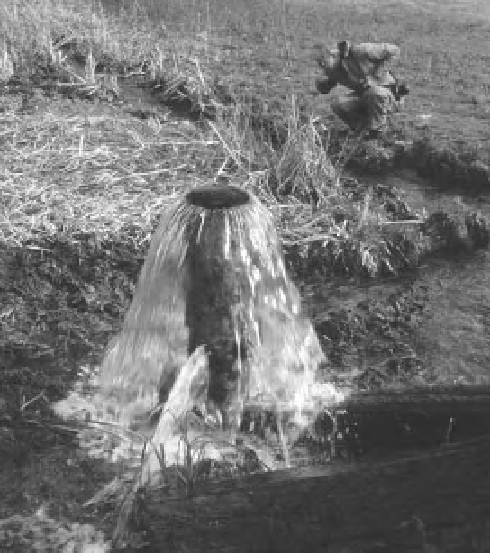Geoscience Reference
In-Depth Information
Figure 4-10.
Water l ows to the surface under its own
pressure in this artesian well in the Flint Hills,
east-central Kansas, United States. Photo by J.S. Aber.
Figure 4-9.
High-capacity water well next to the
Oldman River in south-central Alberta, Canada. Electric
pump lifts water for irrigation on adjacent uplands.
Ground water is recharged from the river in the
background. Photo by J.S. Aber.
hydraulic gradient (change in height over length)
of the water surface, which is a measure of
pressure.
Hydraulic conductivity varies greatly depend-
ing on the porosity of mineral and organic
materials; the sizes, shapes, and connections
between pores as well as water adhesion on
particles all inl uence permeability. In general,
coarse-grained mineral soils have relatively
high permeability, whereas i ne-grained organic
soils have much lower permeability. Hydraulic
conductivity values (
k
pressure to lift water to the surface in so-called
artesian wells (Fig. 4-10). Springs are important
water sources for many wetlands (see Fig. 2-4).
Strictly speaking, wells represent artii cial water
production. Once created, however, artesian
wells may become permanent sources to main-
tain wetlands (Fig. 4-11).
The rate at which ground water moves
through an aquifer or wetland sediment and soil
depends on the nature of the material and the
water pressure. This relationship is expressed as
Darcy's Law (Davis and DeWiest 1966):
=
×
10
−
5
) range
cm/s
>
<
from
0.05 for clay and
dense peat (Mitsch and Gosselink 2007). In the
case of peat, pore size depends on the amount
of decomposition of the plant material, the
degree of compaction, and the type of parent
plant.
Sphagnum
peat generally has the lowest
permeability; peats of higher plants, such as
Carex
and
Phragmites
, are more permeable
(Charman 2002).
Ground water moves both horizontally and
vertically in response to the hydraulic gradient
5000 for sand to
Q
=
k
(
dh dl
/
)
where
Q
is the l ow or discharge (volume
per time),
k
is the hydraulic conductivity or
permeability for the material, and
dh/dl
is the






